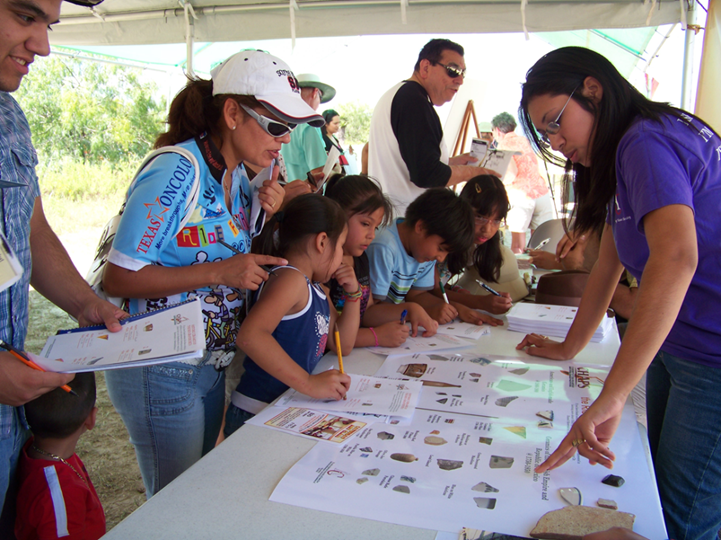
Families dig into the Archeology Fair at Palo Alto Battlefield National Historic Park. Photo courtesy The University of Texas Rio Grande Valley’s Community Historical Archaeology Project with Schools.
For archeologists, “buried treasure” includes pottery fragments, bones, and sharpened stones. During Texas Archeology Month in October, everyone can join them in their quest to find clues about the state’s past.
Those clues are essential to understanding the region’s history, because written records in Texas only go back about 400 years, says Russ Skowronek, a professor of anthropology and history at The University of Texas Rio Grande Valley.
“Written records don’t tell us all the stories,” he says. “So what we count on is the material record.” That is, the physical objects archeologists excavate and analyze.
The month’s events, coordinated by the Texas Historical Commission, take place at universities, museums, and historic sites across the state. Most events are geared for kids and families, but a few lectures, and the Texas Archeological Society’s annual meeting, are just for adults.
One important reminder: “Archaeologists don’t dig dinosaur bones,” says Virginia Moore, the Texas Historical Commission’s interim Texas Archeology Month coordinator. That’s the domain of paleontologists. Make sure kiddoes set their expectations accordingly.
A sampling of events is below; for a full calendar, go here.
San Marcos
Texas Archeological Society Public Forum and Artifact Identification Workshop (Adults only)
Oct. 6
As part of its annual meeting, the Texas Archeological Society invites adults to a free lecture on Friday followed by an artifact identification workshop staffed by experts. TAS member Marybeth Tomka says that people typically bring in projectile points—either arrowheads or darts propelled from an atlatl—or scrapers used for cleaning fur from hides.
In addition to identifying the object, experts at the event explain that once someone pockets an artifact they find on the ground, the object’s utility to archeologists is diminished. “It’s priceless if it’s still on-site and worthless if it’s away from the site,” Tomka says. “Context for archaeologists is everything.” Conversations between archeologists and guests at the workshop have led landowners to invite professionals to excavate sites on their property.
The Oct. 6 event takes place at 7 p.m. at the Embassy Suites by Hilton San Marcos Hotel Conference Center. It includes a lecture by Doug Boyd, “The Tom Cook Blacksmith Shop and the Forgotten History of African American Blacksmiths in Texas,” with the workshop immediately afterward.
Brownsville
Archeology Fair at Palo Alto Battlefield National Historical Park (Kid-friendly)
Oct. 14
Kids can learn about multiple archeology-related fields from students and professors with The University of Texas Rio Grande Valley’s Community Historical Archaeology Project with Schools. A professor who teaches forensic anthropology brings replicas of human skulls and bones and explains how they offer information about the person’s life and death. A zooarcheologist, who studies animal remains found at archeological sites, also brings bones and teeth that reveal not only what animal they belonged to, but whether the animal was wild or domesticated. Volunteers display prehistoric arrowheads and spear points as well as a poster that, with a free augmented reality app visitors can download, explains what various projectile points are made of and where they were found.
Staff from the Palo Alto Battlefield site walk kids through a mini archaeology lab where they measure, weigh, draw, and describe artifacts in an abbreviated version of the process the pros follow. Most of the artifacts are replicas of equipment or pieces of uniforms that soldiers in the Mexican-American War would have used or worn. Visitors can take the artifacts they’ve processed to a historian, dressed as an American or Mexican soldier, to find out how they would have been used. “Some of these items look a little strange, especially if you don’t know what they are, and part of the fun is having people guess,” says Daniel Ibarra, the park’s chief of interpretation.
This event will be held on Oct. 14 from 9 a.m. to noon at Palo Alto Battlefield National Historical Park, located about 10 miles north of downtown Brownsville.
Austin
Texas Archeology Month Fair (Kid-friendly)
Oct. 15
Kids can get a taste of life as an archeologist by working in a dig box, a mock excavation site filled with artifacts such as fragments of ceramic vessels. In the process, they learn that these broken pieces are far more valuable than they initially appear. “You might think this is trash, but for archeologists, this is actually incredibly important,” says Virginia Moore, the Texas Historical Commission’s interim Texas Archeology Month coordinator. “This little fragment can tell us all kinds of information.”
Other activities include rock art painting and atlatl throwing (a precursor to the bow and arrow that was used for hunting big game, such as mammoths). The event takes place Oct. 15, 11 a.m.-4 p.m., at the French Legation State Historic Site.
Freeport
Prehistoric Archeology Day at the Freeport Historical Museum (Kid-friendly)
Oct. 21
Children ages 4-10 can participate in mock excavations and rock art and handle artifacts such as ceramics, arrowheads, shells, and bones. The museum also will introduce families to forensic anthropology by sharing information about Wilma, a woman who lived 3,500 years ago and whose skull was found near Freeport in 2004. Forensic anthropologists studied the skull and determined it belonged to a woman who died when she was in her early 30s. A forensic artist created a facial reconstruction of what the woman would have looked like, and the museum displays a copy of the sculpture.
Head to the Freeport Historical Museum, which features 300 years of city history, for the archeology day event on Oct. 21 between 10 a.m. and 2 p.m.
Throughout the month, across the state: Multiple sites will offer free kits children can use to make pinch pots, one of the world’s oldest forms of pottery, crafted by cultures around the globe. To find a location near you, go here.








